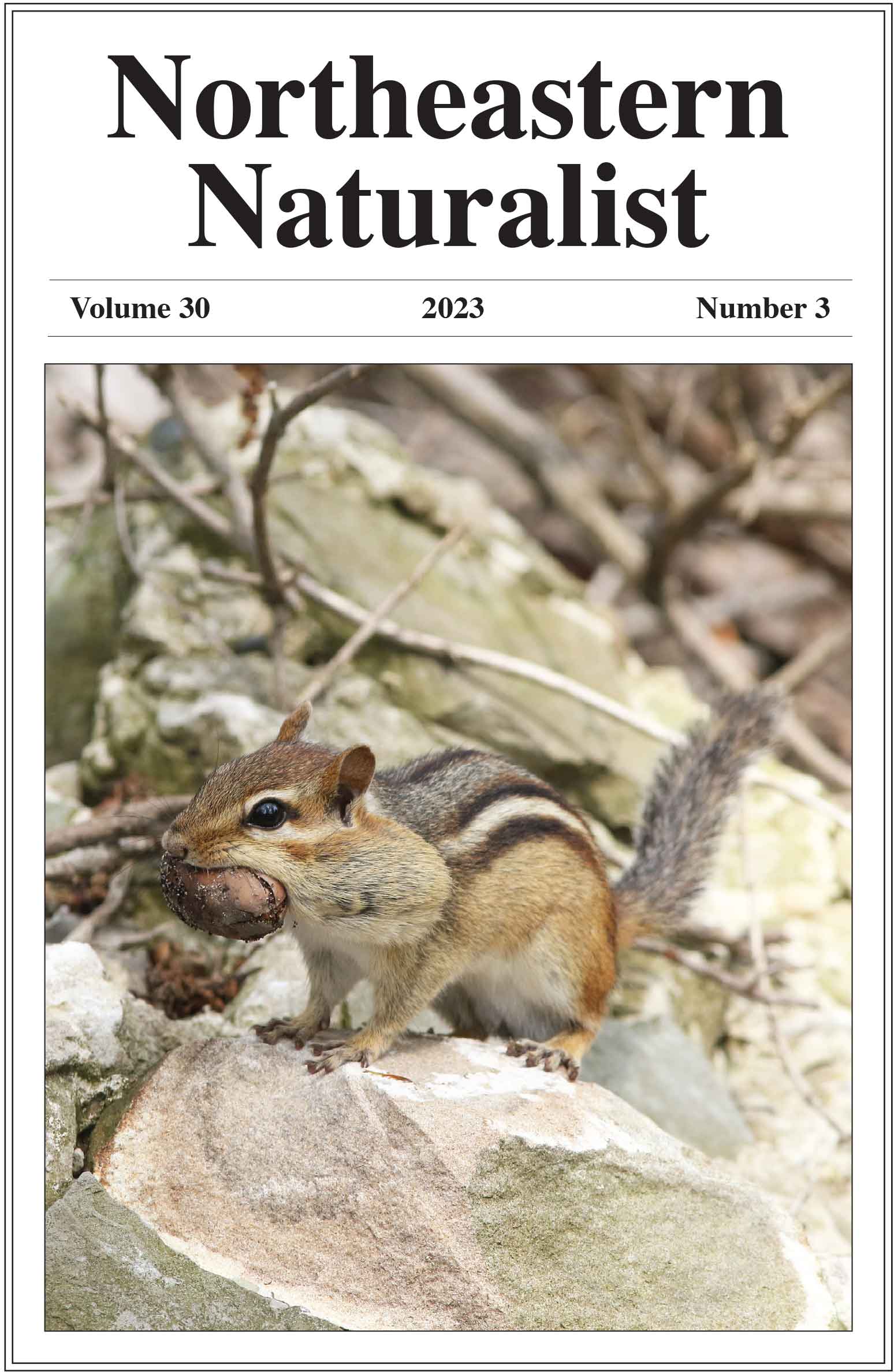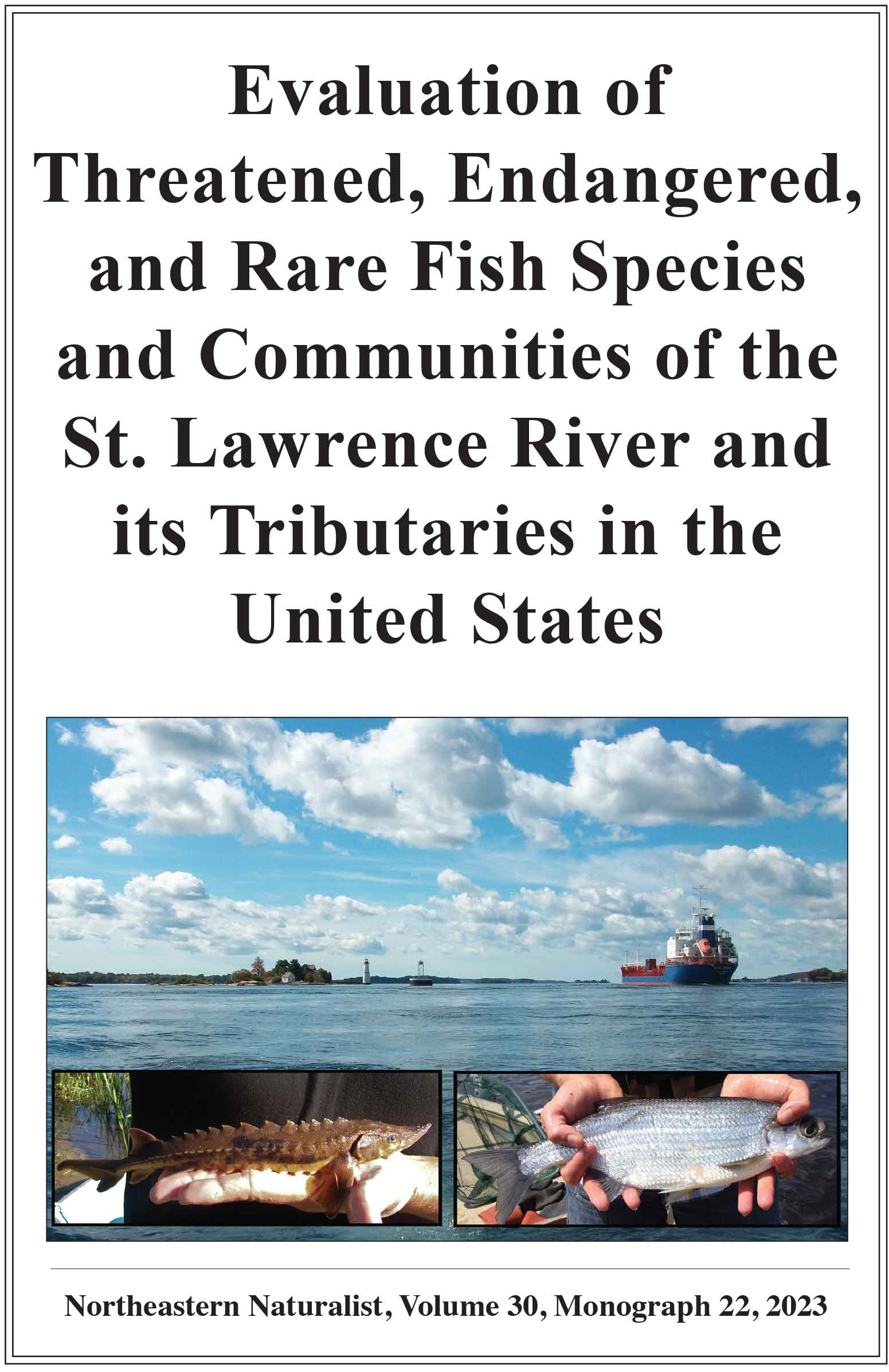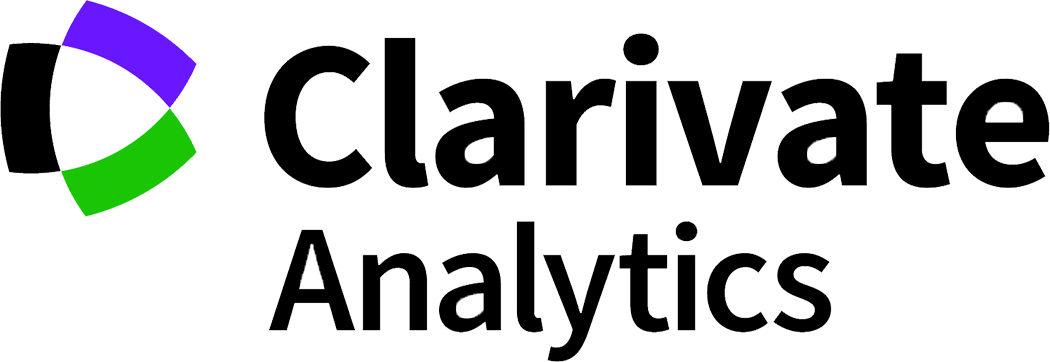Distribution of Native Mussel (Unionidae) Assemblages in
Coastal Areas of Lake Erie, Lake St. Clair, and Connecting
Channels, Twenty-five Years After a Dreissenid Invasion
David T. Zanatta, Jonathan M. Bossenbroek, Lyubov E. Burlakova, Todd D. Crail, Ferenc de Szalay, Traci A. Griffith, Douglas Kapusinski, Alexander Y. Karatayev, Robert A. Krebs, Elizabeth S. Meyer, Wendy L. Paterson, Trevor J. Prescott, Matthew T. Rowe, Don W. Schloesser, and Mary C. Walsh
Northeastern Naturalist, Volume 22, Issue 1 (2015): 223–235
Full-text pdf (Accessible only to subscribers. To subscribe click here.)

Access Journal Content
Open access browsing of table of contents and abstract pages. Full text pdfs available for download for subscribers.
Current Issue: Vol. 30 (3)

Check out NENA's latest Monograph:
Monograph 22









Northeastern Naturalist Vol. 22, No. 1
D.T. Zanatta, et al.
2015
223
2015 NORTHEASTERN NATURALIST 22(1):223–235
Distribution of Native Mussel (Unionidae) Assemblages in
Coastal Areas of Lake Erie, Lake St. Clair, and Connecting
Channels, Twenty-five Years After a Dreissenid Invasion
David T. Zanatta1,*, Jonathan M. Bossenbroek2, Lyubov E. Burlakova3,
Todd D. Crail2, Ferenc de Szalay4, Traci A. Griffith1, Douglas Kapusinski4,
Alexander Y. Karatayev3, Robert A. Krebs5, Elizabeth S. Meyer6,
Wendy L. Paterson1, Trevor J. Prescott5, Matthew T. Rowe1, Don W. Schloesser7,
and Mary C. Walsh6
Abstract - Over the past 25 years, unionid mussels in the Laurentian Great Lakes of
North America have been adversely impacted by invasive dreissenid mussels, which directly
(e.g., by attachment to unionid shells) and indirectly (e.g., by competing for food)
cause mortality. Despite the invasion, unionids have survived in several areas in the presence
of dreissenid mussels. We investigated current spatial patterns in these native mussel
refuges based on surveys for unionid mussels across 48 sampling locations (141 sites) in
2011 and 2012, and documented species abundance and diversity in coastal areas of lakes
St. Clair and Erie. The highest-quality assemblages of native mussels (densities, richness,
and diversity) appear to be concentrated in the St. Clair delta, where abundance continues
to decline, as well as in in Thompson Bay of Presque Isle in Lake Erie and in just a few
coastal wetlands and drowned river-mouths in the western basin of Lake Erie. The discovery
of several new refuge areas suggests that unionids have a broader distribution within
the region than previously thought.
Introduction
The decline of native unionid mussels in the Laurentian Great Lakes of North
America after the introduction and population increases of exotic dreissenid mussels
(Dreissena polymorpha (Pallas) [Zebra Mussel] and Dreissena rostriformis
bugensis (Andrusov) [Quagga Mussel]) has been well documented (Lucy et al.
2014, McGoldrick et al. 2009, Nalepa et al. 1996, Schloesser and Nalepa 1994,
Schloesser et al. 1996, Strayer and Malcolm 2007). Native mussels in lakes Erie
1Central Michigan University, Institute for Great Lakes Research, Biology Department, 217
Brooks Hall, Mount Pleasant, MI 48859. 2University of Toledo, Department of Environmental
Science, Lake Erie Center, 6200 Bayshore Road, Oregon, OH 43616. 3SUNY Buffalo
State, Great Lakes Center, 1300 Elmwood Avenue, Buffalo, NY 14222. 4Kent State University,
Dept. of Biological Sciences, Department of Biological Sciences, 256 Cunningham
Hall, Kent, OH 44242. 5Cleveland State University, Dept. of Biological, Geological, and
Environmental Sciences, 2121 Euclid Avenue, Cleveland, OH 44115. 6Pennsylvania Natural
Heritage Program, Western Pennsylvania Conservancy, 800 Waterfront Drive, Pittsburgh,
PA 15222. 7US Geological Survey, Great Lakes Science Center, 1451 Green Road, Ann
Arbor, MI 48105. *Corresponding author - zanat1d@cmich.edu. (All other authors listed
alphabetically).
Manuscript Editor: Robert Hershler
Northeastern Naturalist
224
D.T. Zanatta, et al.
2015 Vol. 22, No. 1
and St. Clair had been in decline for decades as a result of pollution and habitat
destruction (Nalepa et al. 1991), and the invasion of dreissenids in the late 1980s
and early 1990s sparked fears of complete extirpation of unionids (Mackie and
Schloesser 1996, Ricciardi et al. 1998). Dreissenids attach to shells of other species,
thereby hampering filter feeding, respiration, and reproduction (Schloesser et
al. 1996). Dreissenid mussels also impede movement of native mussels, leading to
their burial in soft and unconsolidated sediments, and increasing drag and likelihood
of their dislodgment by water currents (Burlakova et al. 2000, Karatayev et
al. 1997, Schloesser et al. 1996). Conservation programs for these species have become
increasingly crucial to prevent species loss (Haag 2012, Strayer 2006, Strayer
et al. 2004) because unionid mussels are among the most endangered groups of
animals in North America (Bogan 1993, Lydeard et al. 2004).
In the 25 years since the invasions by dreissenid mussels in the Laurentian
Great Lakes of North America, several locales were identified where native mussels
continue to survive the dreissenid impacts (Bowers and de Szalay 2004, 2005,
2007; Bowers et al. 2005; Carlton 2008; Hebert et al. 1989; McGoldrick et al. 2009;
Nichols and Amberg 1999; Nichols and Wilcox 1997; Schloesser and Masteller
1999; Schloesser et al. 1997; Sherman et al. 2013; Zanatta et al. 2002). We refer
to such sites as unionid “refuges”. Some localities in Lake Erie and Lake St. Clair
contained remnants of once-diverse assemblages (Brown et al. 1938, Goodrich and
van der Schalie 1932, LaRoque and Oughton 1937), and communities may even
have recovered (Crail et al. 2011) in a few areas of Lake Erie where habitat conditions
have somewhat mitigated the impacts of the dreissenids (e.g., Bódis et al.
2014, Bowers and de Szalay 2007, Bryan et al. 2013, Lucy et al. 2014, McGoldrick
et al. 2009, Sherman et al. 2013, Strayer and Malcom 2007).
Knowledge of the extent of unionid refuges in coastal Lake Erie and Lake St.
Clair is limited, as no single comprehensive and cohesive study has been made
to compare mussel assemblages and habitats. Monitoring change is necessary to
develop predictive models and strategies for protecting remaining native mussel
populations in the Great Lakes. Each of the published papers on native mussel
refuges in the Great Lakes cited above focuses on a small number of locations, and
none address how frequently native mussels occur in coastal habitats and how often
they are absent in what appears to be suitable habitat. Toward this end, the objectives
of our study were to : 1) identify the extent of unionid assemblages in coastal
areas in lakes St. Clair and Erie; 2) estimate relative abundance, density, and diversity
of these assemblages, and compare modern and historical species assemblages;
and 3) document shell-size distribution in refuges as potential evidence of recruitment
and/or population stability.
Study area
The 48 localities surveyed in 2011–2012 (Table 1, Fig. 1) included embayments,
coastal wetlands, drowned river-mouths, and deltaic and other shallow-water areas
along shorelines of the United States in Lake St. Clair, the Detroit River, Lake
Erie, and the Niagara River. The sampling localities consisted of areas where either
Northeastern Naturalist Vol. 22, No. 1
D.T. Zanatta, et al.
2015
225
Table 1. Mean numbers of unionids collected per site (± S.E. for locations having multiple sites), species
richness (SR), and effective number of species (eH´; Jost 2006) at 49 locations visited in 2011–2012
from coastal areas of Lake St. Clair, the Detroit River, Lake Erie, and the Niagara River.
Code and locality Waterbody No. sites # specimens SR eH´
1 Pollet Bay Lake St. Clair 2 6.0 ± 6.0 6 5
2 Goose Bay Lake St. Clair 3 40.5 ± 15 11 4
3 Fisher Bay Lake St. Clair 1 20.0 6 4
4 Big Muscamoot Bay Lake St. Clair 5 9.5 ± 3.9 11 6
5 Little Muscamoot Bay Lake St. Clair 3 47.5 ± 13 10 3
6 Pocket Bay Lake St. Clair 1 19.0 2 1
7 Bass Bay Lake St. Clair 2 19.5 ± 19.5 6 4
8 Humbug Island Detroit River 1 0.0 0 0
9 Calf Island Detroit River 1 0.0 0 0
10 Huron River (MI) mouth Detroit River 3 6.0 ± 4.0 9 7
11 Celeron Island Detroit River 1 0.0 0 0
12 La Plaisance Bay Lake Erie 1 9.0 2 1
13 North Maumee Bay Lake Erie 3 46.5 ± 18 6 4
14 North Maumee Bay - Dyked Lake Erie 3 0 0 0
15 Monroe Power Plant Discharge Lake Erie 2 42.0 ± 15 4 1
16 Potters Pond - Ottawa NWR Lake Erie 2 0 0 0
17 Brest Bay Lake Erie 1 0 0 0
18 Cedar Creek/Meinke Marina Lake Erie 1 2.0 2 2
19 Crane Creek Marsh - Ottawa NWR Lake Erie 5 56.0 ± 26.5 10 3
20 Turtle Creek Lake Erie 4 26.0 ± 9.0 4 2
21 Toussaint River - Gath Kurdy Preserve Lake Erie 4 48.0 ± 27.5 7 2
22 Portage River mouth Lake Erie 4 40.0 ± 2.7 5 1
23 Muddy Creek Bay Lake Erie 17 10.0 ± 3.1 10 3
24 Young Marsh Lake Erie 2 22.0 ± 2.0 8 5
25 Sandusky Bay Lake Erie 11 1.3 ± 1.0 5 4
26 Port Clinton Beach Lake Erie 1 1.0 1 1
27 East Harbor Lake Erie 2 23.0 ± 17 3 1
28 Cedar Point - Sandusky Bay Lake Erie 3 1.0 ± 0.6 3 3
29 Griffith Airport - Sandusky BayA Lake Erie 3 3.8 ± 2.7 2 2
30 Huron River (OH) mouth Lake Erie 3 4.4 ± 3.4 5 3
31 Old Woman Creek mouth Lake Erie 3 0.7 ± 0.4 1 1
32 Chapel Creek mouth Lake Erie 1 0.0 0 0
33 Sugar Creek mouth Lake Erie 1 0.0 0 0
34 Raccoon Creek mouth Lake Erie 1 0.0 0 0
35 Elk Creek mouth Lake Erie 2 0.0 0 0
36 Presque Isle Bay Lake Erie 15 0.9 ± 0.4 3 2
37 Thompson Bay – Presque Isle Lake Erie 3 10.0 ± 4.6 7 4
38 Gull Point - Presque Isle Lake Erie 2 0.0 0 0
39 Duck Pond - Presque Isle Lake Erie 2 11.0 ± 10 4 2
40 Twelve Mile Creek mouth Lake Erie 1 0.0 0 0
41 Sixteen Mile Creek mouth Lake Erie 1 0.0 0 0
42 Twenty Mile Creek mouth Lake Erie 1 0.0 0 0
43 Silver Creek mouth/ Walnut Creek mouth Lake Erie 1 0.0 0 0
44 Cattaraugus Creek mouth Lake Erie 1 0.0 0 0
45 Big Sister Creek mouth/ Bennett Beach Lake Erie 1 0.0 0 0
46 Eighteen Mile Creek backwater Lake Erie 2 0.0 0 0
47 Strawberry Island Niagara River 3 28.0 ± 14 3 1
48 Spicer Creek mouth/ Grand Isle Niagara River 1 45.0 4 2
49 Bayshore – South Maumee BayB Lake Erie 4 1201.5 ± 400.5 13 4
Mean values (locations 1–48) 13.1 3.33 1.75
AFrom D. Kapusinski (unpubl. data).
BFrom Bryan et al. (2013) and not included in the analyses (of 48 sites) used herein.
Northeastern Naturalist
226
D.T. Zanatta, et al.
2015 Vol. 22, No. 1
live unionids had been observed in recent years (~10 y), shells had been collected
recently (Crail et al. 2011, McGoldrick et al. 2009, Zanatta et al. 2002), or where
unionids were thought to possibly occur based on habitat features including water
depth (<1 m, protected embayments, drowned river mouths), substrate type (soft
sand or mud), and vegetation (e.g., chara, bullrushes). At each locality, one or more
sites were surveyed depending on areal extent (totaling 141 sites across the 48 locations).
For example, we sampled 17 sites at Muddy Creek Bay (location 24, ~7.4
km2) and 11 sites at inner Sandusky Bay (location 26, ~73 km2), but only sampled
single sites at the mouths of small tributaries (<0.1 km2).
Methods
Each survey site was sampled for unionids within a rectangular-shaped area of
0.5 ha, typically 50 m by 100 m but dimensions were dependent on the layout of
available habitat. We marked the rectangle corners and recorded the coordinates
with a hand-held GPS unit. Each site was searched by tactile methods (due to
poor visibility caused by highly turbid water) for 2 person-hours (e.g., 4 searchers
for 30 minutes each). Search method varied due to substrate type, water
clarity, and water depth; wading, raking, and snorkeling were used at a majority
(90%) of sites. Relatively deep sites (>1.5 m) were sampled by SCUBA. We do
not believe that varying methods biased the results among sites. We identified all
Figure 1. Map showing collection localities (codes from Table 1) in Lake St. Clair, the
Detroit River, Lake Erie, and the Niagara River sampled in 2011–2012. The location of
the study area in northeastern North America is shown in the insert.
Northeastern Naturalist Vol. 22, No. 1
D.T. Zanatta, et al.
2015
227
collected material to species, measured standard shell length of all specimens,
and determined gender for species that have sexually dimorphic shells. Dreissenid
data for these sites was collected as part of another study and is presented
there (see Burlakova et al. 2014).
We determined the mean numbers of unionids per site (± standard error [SE])
for each location by averaging data among sites sampled within each location,
the species richness (SR) by enumeration of the number of species present at a
location (cumulative across sites), and the diversity by a Shannon diversity index
(H´), which we then converted to effective number of species (calculated as eH´,
Jost 2006). We also calculated the mean shell lengths of the 13 most common or
widespread species at each location. The presence of small-size classes (<40 mm
length, except <30 mm length for small species and <20 mm length for Taxolasma
parvum [Lilliput]) in samples was interpreted as evidence of recent recruitment
(Haag 2012).
Results
A total of 1923 live specimens (22 species) was collected from 30 of the locations
sampled between June and August in 2011 and 2012 (Tables 1, 2; Fig. 1). No
mussels were found at the remaining 18 locations. The most abundant species were
Quadrula quadrula (Pimpleback; n = 780), Pyganodon grandis (Giant Floater; n =
311), Lampsilis siliquoidea (Fatmucket Clam; n = 262), Amblema plicata (Threeridge;
n = 199), and Leptodea fragilis (Fragile Papershell; n = 92) (Table 2). Collectively
these 5 species accounted for 85.5% of the total number of specimens.
The most widespread species (proportion of sites found) were: P. grandis (38.9%),
Q. quadrula (27.3%), A. plicata (21.6%), L. fragilis (17.3%), and L. siliquoidea
(14.4%). The assemblages in Lake Erie, the Detroit River, and the Niagara River
differed considerably from that in Lake St. Clair (Table 2). In Lake Erie, Q. quadrula,
P. grandis, and A. plicata dominated numerically, toogether accounting for 84%
of the total assemblage. The most abundant species in Lake St. Clair, in contrast,
were L. siliquoidea, Potamilus alatus (Pink Heelsplitter), Ligumia nasuta (Eastern
Pondmussel), and Villosa iris (Rainbow Mussel), which together accounted for
80% of the assemblage.
The mean abundance of unionids in the St. Clair delta (23.8 ± 6.2 inidviduals/
site) was more than twice that of the other sampled regions grouped together (10.9
± 2.7 individuals/site) (Table 2). However, 5 of the 7 highest-density sites were
in western Lake Erie: at Crane Creek Marsh (location 19), Toussaint Creek (21),
North Maumee Bay (13), Monroe power-plant discharge (15), and the Portage
River mouth (22). Mean unionid abundance in the western basin of Lake Erie was
similar to that of the St. Clair delta, although variation among locations was 40%
higher than in the latter (Table 3). Evidence of recent recruitment was found for 9 of
the 13 most common species, but at only 11 of the 48 locations surveyed (Table 4):
3 in Lake St. Clair, 5 in the western basin of Lake Erie, 2 in Sandusky Bay, and just
1 farther east, at Presque Isle, PA.
Northeastern Naturalist
228
D.T. Zanatta, et al.
2015 Vol. 22, No. 1
Discussion
Our findings provide further evidence that Great Lakes nearshore beach/littoral
habitats still contain native mussel populations (Crail et al. 2011, Schloesser et
al. 1997) despite the presence of dreissenids and a long history of declining water
Table 2. Comparison between unionid assemblages in Lake St. Clair and Lake Erie and the Detroit
and Niagara rivers in 2011–2012. Rel. abund. = relative abundance; % of sites = proportion of all sites
in which species was found.
Waterbody
Lake Erie and
Detroit and
Lake St. Clair Niagara rivers
# of Rel. # of Rel. % of
Species mussels abund. mussels abund. sites
Subfamily Anodontinae
Anodontoides ferussacianus Lea (Cylindrical Papershell) 1 0.2% 0 0.0% 0.7%
Lasmigona complanata Barnes (White Heelsplitter) 0 0.0% 23 1.5% 8.6%
Lasmigona costata Rafinesque (Flutedshell) 5 1.2% 0 0.0% 2.9%
Pyganodon grandis (Say) (Giant Floater) 13 3.1% 298 19.8% 38.9%
Strophitus undulatus Say (Squawfoot) 12 2.9% 0 0.0% 2.9%
Utterbackia imbecillis (Say) (Paper Pondshell) 0 0.0% 9 0.6% 2.2%
Subfamily Ambleminae
Tribe Amblemini/Pleurobemini/Quadrulini
Amblema plicata Say (Threeridge) 12 2.9% 187 12.4% 21.6%
Elliptio dilatata Rafinesque (Spike) 1 0.2% 0 0.0% 0.7%
Fusconaia flava Rafinesque (Wabash Pigtoe) 21 5.1% 22 1.5% 8.6%
Pleurobema sintoxia Rafinesque (Round Pigtoe) 2 0.5% 1 0.1% 1.4%
Quadrula pustulosa Lea (Pimpleback) 0 0.0% 5 0.3% 2.9%
Quadrula quadrula Rafinesque (Mapleleaf) 0 0.0% 780 51.7% 27.3%
Tribe Lampsilini
Lampsilis cardium Rafinesque (Plain Pocketbook) 14 3.4% 1 0.1% 5.0%
Lampsilis siliquoidea Barnes (Fatmucket Clam) 251 60.5% 11 0.7% 14.4%
Leptodea fragilis Rafinesque (Fragile Papershell) 2 0.5% 90 6.0% 17.3%
Ligumia nasuta Say (Eastern Pondmussel) 24 5.8% 28 1.9% 10.8%
Ligumia recta Lamarck (Black Sandshell) 1 0.2% 0 0.0% 0.7%
Obliquaria reflexa Rafinesque (Three-horn Wartyback) 0 0.0% 10 0.7% 4.3%
Potamilus alatus (Say) (Pink Heelsplitter) 35 8.4% 22 1.5% 12.2%
Toxolasma parvum (Barnes) (Lilliput) 0 0.0% 15 1.0% 7.9%
Truncilla donaciformis Lea (Fawnsfoot)* 0 0.0% 0* 0.0% 0.7%
Truncilla truncata Rafinesque (Deertoe) 0 0.0% 6 0.4% 3.6%
Villosa iris (Lea) (Rainbow Mussel) 21 5.1% 0 0.0% 5.0%
Total unionids 415 1508
Total collection sites 17 sites 125 sites
Abundance (unionids/site ± S.E.) 23.8 ± 6.2 10.9 ± 2.7
Species richness (SR) 15 16
Shannon diversity (H´) 1.55 1.53
Effective number of species 5 5
*Many were collected during a fall seiche at Bayshore (Maumee Bay) in October 2011 (Bryan et al.
2013).
Northeastern Naturalist Vol. 22, No. 1
D.T. Zanatta, et al.
2015
229
quality (Nalepa et al. 1991). The present study encompassed a much wider geographic
area than previous investigations (e.g., Lake St. Clair delta [McGoldrick
et al. 2009, Zanatta et al. 2002], Crane Creek [Bowers and de Szalay 2004], and
Presque Isle Bay of Lake Erie [Masteller et al. 1993]), and all surveys were obtained
within a 2-year time frame, which allowed for comparison of abundance,
richness, and diversity among locations not possible with previous data .
Five of the seven sites surveyed in the St. Clair delta had among the highest
species richness and diversity in the entire region surveyed. Interestingly, the
composition of the unionid assemblages in Lake St. Clair has changed little since
1986, prior to the Zebra Mussel invasion (Nalepa and Gauvin 1988). However,
assemblages on the Canadian side of the delta (Pocket Bay and Bass Bay), which
Table 4. Shell lengths, locations (codes from Table 1) with evidence of recent recruitment (length < 40
mm*,†), and proportion of locations with evidence of recent recruitment for common and/or widely
distributed species in coastal areas of Lake St. Clair, the Detroit River, Lake Erie, and the Niagara
River visited in 2011–2012.
Range of Locations with Proportion of locations
shell lengths in mm evidence of with evidence of recent
Species (# of individuals) recent recruitment recruitment (# of locations)
Amblema plicata 15–126 (n = 199) 13, 19, 21, 23 25% (n = 16)
Fusconaia flava* 26–81 (n = 43) 2, 3, 4 27% (n = 11)
Lampsilis siliquoidea 34–151 (n = 262) 2 13% (n = 8)
Lasmigona complanata 24–165 (n = 23) 19 20% (n = 5)
Leptodea fragilis 11–158 (n = 92) 13, 19, 25 20% (n = 15)
Ligumia nasuta 49–110 (n = 52) - - (n = 10)
Obliquaria reflexa* 17–63 (n = 10) 15, 19, 25 60% (n = 5)
Potamilus alatus 58–138 (n = 57) - - (n = 16)
Pyganodon grandis 11–155 (n = 311) 13, 25, 37 12% (n = 25)
Quadrula quadrula 11–117 (n = 780) 19, 21, 22, 23, 25, 30 50% (n = 12)
Strophitus undulatus* 33–43 (n = 12) - - (n = 3)
Toxolasma parvum† 14–41 (n = 15) 19, 25, 30 43% (n = 7)
Villosa iris* 36–67 (n = 21) - - (n = 5)
*Recent recruits for small species considered when length < 30 mm.
†Recent recruits for T. parvum considered when length < 20 mm.
Table 3. Mean unionid abundance by location visited in 2011–2012 across 6 bathymetrically separate
regions of the Lake Erie watershed, and the coefficient of variation (V) among locations in
each region.
Number of Mean number of
Regions locations unionids/site SE V
Lake St. Clair 7 23.8 6.2 34.4
Detroit River 4 3.0 1.5 100.0
Lake Erie western basin 13 22.5 6.0 48.2
Lake Erie Sandusky Bay 5 9.3 4.4 59.2
Lake Erie central basin 10 2.7 1.4 80.7
Lake Erie eastern basin 9 8.1 5.6 102.6
Niagara River 48 12.1 2.5 69.4
Northeastern Naturalist
230
D.T. Zanatta, et al.
2015 Vol. 22, No. 1
contained several rare species and have been considered among the highestquality
refuges in the region (McGoldrick et al. 2009, Zanatta et al. 2002), may
be in decline. In Lake Erie, the highest native mussel abundance we found exists
near the warm-water discharge of the Bayshore power plant in Maumee Bay (location
49; Fig. 1), where unionids were collected during a seiche (standing wave)
event (Bryan et al. 2013) that caused the water levels at that site to drop considerably
at that time. However, data collected during a seiche event are not directly
comparable to methods used in the present study because sampling is much more
effective where large areas of the lake bottom are exposed. The sampling revealed
13 species and >1200 unionids in a 0.5-ha site, which is two orders of magnitude
higher than that of any location surveyed in the present study. Other Lake Erie
locations in which we found a large number of species were the mouth of the
Huron River, MI; several of the large drowned river-mouths of the western basin
(Toussaint Creek, Turtle Creek, and the Portage River), and two coastal wetlands
(North Maumee Bay and Young Marsh). The latter two locations have habitats
similar to Crane Creek (Bowers and de Szalay 2007, Bowers et al. 2005). Similar
to the results of Schloesser et al. (2006), we found few unionids around islands
at the outlet of the Detroit River. Only one location outside of western Lake Erie
(Thompson Bay, outer Presque Isle Bay) still possessed a remnant mussel assemblage
that apparently does not contain dreissenids (Burlakova et al. 2014), but
populations in that region were much reduced compared to those reported by Masteller
et al. (1993).
Many of trhe sampling localities in central and eastern Lake Erie had few or no
unionids (e.g., locations 34–46; Fig. 1). While relatively large densities of unionids
were found at 2 locations in the upper Niagara River, neither of these had relatively
high species richness or diversity (instead they were numerically dominated by
L. siliquoidea and P. grandis), and none showed evidence of recent recruitment.
Unexpectedly , and despite intensive sampling, the large, shallow (generally <2 m
depth) region of Sandusky Bay (in western Lake Erie) contained small populations.
Densities there were low and often below detectable limits, which equated to a large
number of coastal sites where no mussels were found (albeit with evidence of recent
recruitment for several species). Most individuals in Sandusky Bay were found in
the mouth of the Sandusky River where it flows into Muddy Creek Bay (location
23), and few specimens occurred in the bay itself.
Therefore , as abundances declined in Lake Erie, species assemblages have
shifted compared to those of the 1950s and 1980s (Nalepa et al. 1991). Lake assemblages
were previously dominated numerically by L. siliquoidea, P. grandis,
and L. nasuta (Nalepa et al. 1991), as is still the case in Lake St. Clair. The coastal
assemblage present in western Lake Erie has become dominated by Q. quadrula,
P. grandis, and A. plicata, although unionid richness (SR) and diversity metrics (H´
and effective number of species) have rebounded to levels similar to that found
in Lake Erie in the 1950s (Nalepa et al. 1991). A recent geographic expansion is
suggested by the present results because Q. quadrula was rarely collected in earlier
surveys (e.g., Clark 1944, Nalepa and Gauvin 1988).
Northeastern Naturalist Vol. 22, No. 1
D.T. Zanatta, et al.
2015
231
The shift in species composition in Lake Erie is potentially a result of differential
tolerance to mortality caused by dreissenid mussels. Studies from the
1990s, not long after Zebra Mussels invaded Lake Erie (ca. mid-1980s), suggest
that some unionid species were more likely to survive dreissenid fouling than
others (reviewed in Schloesser et al. 1996). Explanations for unionid survival
included the ability to burrow quickly, gender (males appeared to be less impacted
than brooding females), shell robustness (thick/heavy shelled species
seemed to be less affected), and the length of brooding period (species with
short brooding time were found to be less influenced). These characteristics,
which are shared by many of the taxa that live in drowned river-mouths and
shallow embayments (e.g., A. plicata, species of Quadrula and Fusconaia) correspond
to an equilibrium life-history strategy (Haag 2012). The robust shells
and short-term brooding period of these surviving species may well give them
some resilience to dreissenid fouling. Two other species predominantly found in
Lake Erie, L. fragilis and P. grandis, possess an opportunistic strategy of high
fecundity, early age of reproduction, and short life spans (Haag 2012). Although
these 2 species were not especially abundant in the stream mouths, fresh empty
shells of both were frequently found on beaches (Crail et al. 2011). Host-fish
abundance may have contributed to their persistence as well; P. grandis is a host
generalist, and Leptodea fragilis appears to be dependent on Aplodinotus grunniens
(Rafinesque 1819) (Freshwater Drum; Watters et al. 2009), a large benthic
molluscivore fish that has become very abundant in western Lake Erie since
dreissenid mussels invaded (ODW 2013).
Our evidence for recent recruitment correlated well with abundance, richness,
and diversity. Although our sampling methods were not especially efficient at detecting
juvenile unionids, 9 of the 13 most-common and/or widespread species—
including Q. quadrula, P. grandis, and A. plicata in western Lake Erie—showed
evidence of recruitment at several locations. In contrast, a concern exists that some
of the more common species in the St. Clair delta (e.g., L. siliquoidea and L. nasuta)
and Presque Isle (e.g., A. plicata, F. flava, and L. nasuta) exhibited few signs of
recent reproduction.
These results lead to a final important question: what varies between sites
with and without unionids? This study described the current distribution of native
mussel assemblages in Lake St. Clair and Lake Erie, and research continues
to characterize and model habitat variables of refuges that enable unionids to
persist at those locations. Sherman et al. (2013) found that while both North
Maumee Bay in Lake Erie and the delta of Lake St. Clair contain unionids, they
differ in habitat features (drowned river-mouth vs. deltaic), substrate (softer in
Lake Erie), and water chemistry (higher pH and turbidity in Lake Erie). The
St. Clair deltaic environment may suppress dreissenid impacts because its flow
remains river-like with a retention/replacement time of only 7 days compared
to 2.6 years for Lake Erie (GLIN 2014). A persistent flow may allow periodic
life-history strategists, including L. siliquoidea and L. nasuta, to sustain
populations; we note in this context that the unionid assemblage of the St. Clair
Northeastern Naturalist
232
D.T. Zanatta, et al.
2015 Vol. 22, No. 1
delta is similar to those of small streams in the Mississippi watershed (Haag
2012:table 8.1) with the addition of 4 species presumed to use Freshwater Drum
as a host fish (L. fragilis, P. alatus, Truncilla truncata, and T. donaciformis;
Watters et al. 2009) and therefore not typically present in small streams. North
Maumee Bay had the highest water-level fluctuations (>1 m water-level changes
during seiches) of any of the locations from across the Great Lakes, a characteristic
that may largely exclude dreissenid mussels.
The native mussel compositions we found in 2011–2012 are difficult to directly
compare to species compositions found in previous studies. Most offshore sampling
suggested a limited unionid presence, and therefore coastal refuges may represent
the vast majority of what remains in Lake Erie. Within coastal refuges of western
Lake Erie, species composition has changed in comparison to historical assemblages.
Lake St. Clair populations showed signs of decline, although the aggregate
community has not changed substantially. Our main concern is that the remaining
species assemblages will succumb to mortality caused by dreissenid mussels. Only
time will tell whether shifts that have been observed in Lake Erie will also occur in
Lake St. Clair in the future.
Acknowledgments
Funding for this project was provided by the US Fish and Wildlife Service, Great Lakes
Fish and Wildlife Restoration Act (project No. 30191-A-G152). Scientific collection permits
were provided by wildlife agencies of Michigan, Ohio, Pennsylvania, New York, and
Ontario. Special thanks to the dive crew, J. Bateman, G. Longton, D. Okon, and M. Shackelford,
from DTE Energy. Additional assistance in the field was provided by: M. Scott,
E. Nederhoed, J. Bergner, J. Twichell, E. Bertram, L. Adams, L. Kolich, and E. Marlow from
Central Michigan University; B. Morgan, M. Hickin, B. Brdek, J. Martin, and K. Shreve
from Kent State University; M. Begley from Cleveland State University; N. Bryan, C. Florence,
S. Schnapp, J. Sieracki, and L. Volmar from the University of Toledo; R. Miller, A.
Halmi, and C. Folb from Western Pennsylvania Conservancy; Dr. E. Masteller from the Tom
Ridge Environmental Center; V. Karatayev from Cornell University; and I. Porto-Hannes
from SUNY University at Buffalo. Dr. T. Morris of Fisheries and Oceans Canada and the
Walpole Island First Nation facilitated access to sites on the Canadian side of the St. Clair
delta. Thanks to Dr. R. Hershler and 2 anonymous reviewers for making suggestions to improve
this manuscript. This article is contribution #47 of the Central Michigan University
Institute for Great Lakes Research and contribution #1888 of the USGS Great Lakes Science
Center, USGS, Ann Arbor, MI.
Literature Cited
Bódis, E., B. Tóth, and R. Sousa. 2014. Impacts of Dreissena fouling on the physiological
condition of native and invasive bivalves: Interspecific and temporal variations. Biological
Invasions 16:1373–1386.
Bogan, A.E. 1993. Freshwater bivalve extinctions (Mollusca: Unionoida): A search for
causes. American Zoologist 20:599–609.
Bowers, R.J., and F.A. de Szalay. 2004. Effects of hydrology on unionids (Unionidae) and
Zebra Mussels (Dreissenidae) in a Lake Erie coastal wetland. American Midland Naturalist
151:286–300.
Northeastern Naturalist Vol. 22, No. 1
D.T. Zanatta, et al.
2015
233
Bowers, R.J., and F.A. de Szalay. 2005. Effects of water-level fluctuations on Zebra Mussel
distribution in a Lake Erie coastal wetland. Journal of Freshwater Ecology 20:85–92.
Bowers, R.J., and F.A. de Szalay. 2007. Fish predation of Zebra Mussels attached to Quadrula
quadrula (Bivalvia: Unionidae) and benthic molluscs in a Great Lakes coastal
wetland. Wetlands 27:203–208.
Bowers, R.J., C. Sudomir, M.W. Kershner, and F.A. de Szalay. 2005. The effects of predation
and unionid burrowing on bivalve communities in a Laurentian Great Lake coastal
wetland. Hydrobiologia 545:93–102.
Brown, C.J.D., C. Clark, and B. Gleissner. 1938. The size of certain naiades from western
Lake Erie in relation to shoal exposure. American Midland Naturalist 19:682–701.
Bryan, N.J., C.V. Florence, T.D. Crail, and D.L. Moorhead. 2013. Freshwater mussel community
response to warm-water discharge in western Lake Erie. Journal of Great Lakes
Research 39:449–454.
Burlakova, L.E., A.Y. Karatayev, and D.K. Padilla. 2000. The impact of Dreissena polymorpha
(Pallas) invasion on unionid bivalves. International Review of Hydrobiology
85:529–541.
Burlakova, L.E., B.L. Tulumello, A.Y. Karatayev, R.A. Krebs, D.W. Schloesser, W.L. Paterson,
T.A. Griffith, M.W. Scott, T.D Crail, and D.T. Zanatta. 2014. Competitive replacement
of invasive congeners may relax impact on native species: Interactions among
Zebra, Quagga, and native unionid mussels. PLoS ONE 9(12):e114926.
Carlton, J.T. 2008. The Zebra Mussel, Dreissena polymorpha, found in North America in
1986 and 1987. Journal of Great Lakes Research 34:770–773.
Clark, C.F. 1944. The fresh-water naiades of Auglaize County, Ohio. Ohio Journal of Science
44:167–176.
Crail T.D., R.A. Krebs, and D.T. Zanatta. 2011. Unionid mussels from nearshore zones of
Lake Erie. Journal of Great Lakes Research 37:199–202.
Goodrich, C., and H. van der Schalie H. 1932. I. On an increase in the naiad fauna of Saginaw
Bay, Michigan. II. The naiad species of the Great Lakes. Occasional Papers of the
Museum of Zoology, University of Michigan 238:1–14.
Great Lakes Information Network (GLIN). 2014. The Great Lakes. Avialable online at
http://www.great-lakes.net/lakes. Accessed April 2014.
Haag, W.R. 2012. North American Freshwater Mussels: Natural History, Ecology, and
Conservation. Cambridge University Press, Cambridge UK.
Hebert, P.D.N., B.W. Muncaster, and G.L. Mackie. 1989. Ecological and genetic studies on
Dreissena polymorpha (Pallas): A new mollusc in the Great Lakes. Canadian Journal of
Fisheries and Aquatic Sciences 46:1587–1591.
Jost, L. 2006. Entropy and diversity. Oikos 113:363–375.
Karatayev, A.Y., L.E. Burlakova, and D.K. Padilla. 1997. The effect of Dreissena polymorpha
(Pallas) invasion on aquatic communities in Eastern Europe. Journal of Shellfish
Research 16:187–203.
La Rocque A., and J. Oughton. 1937. A preliminary account of the Unionidae of Ontario.
Canadian Journal of Research 15:147–155.
Lucy, F., L.E. Burlakova, A.Y. Karatayev, S.E. Mastitsky, D.T. Zanatta. 2014. Zebra Mussel
impacts on unionids: A synthesis of trends in North America and Europe. Pp. 623–646,
In T.F. Nalepa, and D.W. Schloesser (Eds.). Quagga and Zebra Mussels: Biology, Impact,
and Control, 2nd Edition. CRC Press, Boca Raton, FL.
Lydeard, C., R.H. Cowie, W.F. Ponder, A.E. Bogan, P. Bouchet, S.A. Clark, K.S. Cummings,
T.J. Frest, O. Gargonminy, D.G. Herbert, R. Hershler, K.E. Perez, B. Roth, M.
Seddon, E.E. Strong, and F.G. Thompson. 2004. The global decline of nonmarine mollusks.
Bioscience 54:321–330.
Northeastern Naturalist
234
D.T. Zanatta, et al.
2015 Vol. 22, No. 1
Mackie, G.L., and D.W. Schlosser. 1996. Comparative biology of Zebra Mussels in Europe
and North America: an overview. American Zoologist 36:244–258.
Masteller, E.C., K.R. Maleski, and D.W. Schloesser. 1993. Unionid bivalves (Mollusca: Bivalvia:
Unionidae) of Presque Isle Bay, Erie, Pennsylvania. Journal of the Pennsylvania
Academy of Science 67:120–126.
McGoldrick D.J., J.L. Metcalfe-Smith, M.T. Arts, D.W. Schloesser, T.J. Newton, G.L.
Mackie, E.M. Monroe, J. Biberhofer, and K. Johnson. 2009. Characteristics of a refuge
for native freshwater mussels (Bivalvia: Unionidae) in Lake St. Clair. Journal of Great
Lakes Research 35:137–146.
Nalepa T.F., and J.M. Gauvin. 1988. Distribution, abundance, and biomass of freshwater
mussels (Bivalvia: Unionidae) in Lake St. Clair. Journal of Great Lakes Research
14:411–419.
Nalepa, T.F., B.A. Manny, J.C. Roth, S.C. Mozley, D.W. Schloesser. 1991. Long-term
decline in freshwater mussels (Bivalvia: Unionidae) of the western basin of Lake Erie.
Journal of Great Lakes Research 17:214–219.
Nalepa, T.F., D.J. Hartson, G.W. Gostenik, D.L. Fanslow, and G.A. Lang. 1996. Changes
in the freshwater mussel community of Lake St. Clair: From Unionidae to Dreissena
polymorpha in eight years. Journal of Great Lakes Research 22:354–369.
Nichols, S.J., and J. Amberg. 1999. Co-existence of Zebra Mussels and freshwater unionids:
Population dynamics of Leptodea fragilis in a coastal wetland infested with Zebra Mussels.
Canadian Journal of Zoology 77:423–432.
Nichols, S.J., and D.A. Wilcox. 1997. Burrowing saves Lake Erie clams. Nature 389:921.
Ohio Division of Wildlife (ODW). 2013. Ohio’s Lake Erie fisheries, 2012. Annual status
report. Federal Aid in Fish Restoration Project F-69-P. Ohio Department of Natural
Resources, Division of Wildlife, Lake Erie Fisheries Units, Fairport and Sandusky, OH.
121 pp.
Ricciardi, A., R.J. Neves, and J.B. Rasmussen. 1998. Impending extinctions of North
American freshwater mussel (Unionoida) following the Zebra Mussel (Dreissena polymorpha)
invasion. Journal of Animal Ecology 67:613–619.
Schloesser, D.W., and E.C. Masteller. 1999. Mortality of unionid bivalves (Mollusca) associated
with dreissenid mussels (Dreissena polymorpha and D. bugensis) in Presque
Isle Bay, Lake Erie. Northeastern Naturalist 6:341–352.
Schloesser, D.W., and T.F. Nalepa. 1994. Dramatic decline of unionid bivalves in offshore
waters of western Lake Erie after infestation by the Zebra Mussel, Dreissena polymorpha.
Canadian Journal of Fisheries and Aquatic Sciences 51:2234–2242.
Schloesser, D.W., T.F. Nalepa, and G.L. Mackie. 1996. Zebra Mussel infestation of unionid
bivalves (Unionidae) in North America. American Zoologist 36:300–310.
Schloesser, D.W., R.D. Smithee, G.D. Longton, and W.P. Kovalak. 1997. Zebra Musselinduced
mortality of unionids in firm substrata of western Lake Erie and a habitat for
survival. American Malacological Bulletin 14:67–74.
Schloesser, D.W., J.L. Metcalfe-Smith, W.P. Kovalak, G.D. Longton, and R.D. Smithee.
2006. Extirpation of freshwater mussels (Bivalvia: Unionidae) following the invasion of
dreissenid mussels in an interconnecting river of the Laurentian Great Lakes. American
Midland Naturalist 155:307–320.
Sherman, J.J., B.A. Murry, D.A. Woolnough, D.T. Zanatta, and D.G. Uzarski. 2013. Assessment
of remnant unionid assemblages in a selection of Great Lakes coastal wetlands.
Journal of Great Lakes Research 39:201–210.
Strayer, D.L. 2006. Challenges for freshwater invertebrate conservation. Journal of the
North American Benthological Society 25:271–287.
Northeastern Naturalist Vol. 22, No. 1
D.T. Zanatta, et al.
2015
235
Strayer, D.L., and H.M. Malcom. 2007. Effects of Zebra Mussels (Dreissena polymorpha)
on native bivalves: The beginning of the end or the end of the beginning. Journal of the
North American Benthological Society 26:111–122.
Strayer, D.L., J.A. Downing, W.R. Haag, T.L. King, J.B. Layzer, T.J. Newton, and S.J.
Nichols. 2004. Changing perspectives on pearly mussels, North America's most imperiled
animals. BioScience 54:429–439.
Watters, G.T., M.A. Hoggarth, and D.H. Stansbery. 2009. The Freshwater Mussels of Ohio.
The Ohio State University Press, Columbus, OH.
Zanatta, D.T., G.L. Mackie, J.L. Metcalfe-Smith, and D.A. Woolnough. 2002. A refuge
for native freshwater mussels (Bivalvia: Unionidae) from impacts of the exotic Zebra
Mussel (Dreissena polymorpha) in Lake St. Clair. Journal of Great Lakes Research
28:479–489.












